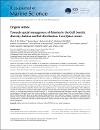Towards spatial management of fisheries in the Gulf: Benthic diversity, habitat and fish distributions from Qatari waters
| المؤلف | Walton, Mark E M |
| المؤلف | Hayes, Jamie |
| المؤلف | Al-Ansi, Mohsin |
| المؤلف | Abdallah, Mohamed |
| المؤلف | Al Maslamani, Ibrahim |
| المؤلف | Al-Mohannadi, Mohammed |
| المؤلف | Al-Shaikh, Ismail |
| المؤلف | D’Urban Jackson, Tim |
| المؤلف | Szostek, Claire |
| المؤلف | Egerton, Jack |
| المؤلف | Kaiser, Michel J |
| المؤلف | Le Vay, Lewis |
| تاريخ الإتاحة | 2024-03-25T04:28:08Z |
| تاريخ النشر | 2018 |
| اسم المنشور | ICES Journal of Marine Science |
| المصدر | Scopus |
| الرقم المعياري الدولي للكتاب | 10543139 |
| الملخص | As with many other regions in the world, more complete information on the distribution of marine habitats in the Gulf is required to inform environmental policy, and spatial management of fisheries resources will require better understanding of the relationships between habitat and fish communities. Towed cameras and sediment grabs were used to investigate benthic habitats and associated epifauna, infauna and fish communities in the central Gulf, offshore from the east coast of Qatar, in water depths of between 12 and 52 m. Six different habitats were identified: (i) soft sediment habitats of mud and (ii) sand, and structured habitats of (iii) macro-algal reef, (iv) coral reef, (v) mixed reef, and (vi) oyster bed. The epibenthic community assemblage of the mud habitat was significantly different to that of sand, which in turn differed from the structured habitats of coral reef, mixed reef and oyster bed, with the macroalgal assemblage having similarities to both sand and the other structured habitats. Fish assemblages derived from video data did not differ between habitats, although certain species were only associated with particular habitats. Epibenthic diversity indices were significantly lower in mud, sand and macro-algal habitats, with no differences recorded for fish diversity. Soft sediment grab samples indicated that mud habitats had the highest benthic diversity, with Shannon-Weiner values of >4, and were more diverse than sand with values of 3.3. The study demonstrates high biodiversity in benthic habitats in the central and southwestern Gulf, which may in part be due to the absence of trawling activity in Qatari waters. There is a strong influence of depth on benthic habitat type, so that depth can be used to predict habitat distribution with a high level of accuracy. The presence of outcrops of hard substrata creates a mosaic of patchy shallow structured benthic habitat across extensive areas of the offshore seabed. Such heterogeneity, and the association of commercially exploited fish species with specific habitats, indicates that this region is well suited to a spatial approach to fisheries management. |
| راعي المشروع | This research was supported by the project "Identification of Essential Fish Habitat to Achieve An Ecosystem-Based approach to Fisheries Management" funded by the Qatar National Research Foundation (QNRF) NPRP 6-1680-4-027. We would particularly like to thank Jodie Haig, Julia Pantin, Harriet Salomonsen, Gwladys Lambert, Caesar Sorino, Abdulrahman Albinali, Yousif Alkahalaf for participation in survey cruises on the RV Janan, and Ms. Aisha Al-Ashwel, Ms. Najat Al-Omary, and Ms. Noora Ali Alfardi for help with benthic infauna species identification and Manal Ibrahim, Noora Alshammari for fish laboratory work. We would also like to thank the reviewers and the editor, Dr Norkko, whose thoughtful comments greatly improved the manuscript. |
| اللغة | en |
| الناشر | Oxford University Press |
| الموضوع | Arabian Gulf Benthos Biodiversity Fish density Habitat ROPME Sea Area Spatial management |
| النوع | Article |
| الصفحات | 178-189 |
| رقم العدد | 1 |
| رقم المجلد | 75 |
الملفات في هذه التسجيلة
هذه التسجيلة تظهر في المجموعات التالية
-
مجموعة العلوم البحرية [215 items ]


